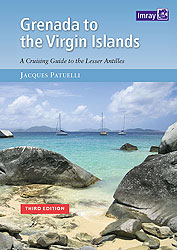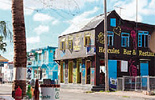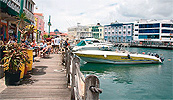| |
|

Barbados lies some 80M to windward of
the chain of the Antilles, so Columbus
never came across it on his many
voyages. Pedro a Campos and his
Portuguese crew were the first to discover
it in 1536 when heading for Brazil.
Impressed by all the bearded fig trees on
the island, they named it ‘Isla de los
Barbados’, the Island of Beards. The
name stuck when the first English
colonists arrived in 1627, when they
founded Jamestown (Holetown). At that
time there were apparently no remaining
traces of the original pre-Columbian
population that had once lived there.
Thanks to its geographical position
Barbados was untouched by the Anglo-
French wars. The result was that the
British influence was continuous for
more than three centuries. The effects
remain today, for the island is so marked
by British traditions and manners that
it’s nicknamed ‘Little England’.
In the 18th century the development
of a sugar monoculture made Barbados
the biggest English colonial sugar
producer. It depended, of course, on the
massive import of slaves from Africa who
were the ancestors of 95% of today’s
population. The tiny population of white
people is not the remnant of the great
sugar estate owning families, but of those
condemned for religious or political
dissent and deported here from Britain
by various governments.
Though these days any discrimination
in Barbados has less to do with the colour
of your skin than with your wealth and
social status.

Independent since 1966, the island’s
inhabitants think of themselves above
all as Barbadians (or Bajans), although
they still retain some very British ways,
such as ‘tea time’ in their flower covered
cottages, and the uniform of the
policemen.
The people are very religious.
Although there is a multiplicity of sects,
the Anglican church dominates and the
island is divided into numerous parishes,
each with its church.
Population density is among the
world’s highest and sugar cane and its
by-products still represent one part of
the people’s economic resources. To this
we can add fishing (the Bajans have a
fine reputation as sailors) and market
gardening. However, in response to the
depression in the world sugar market, in
order to maintain their standard of living
(one of the highest amongst the old
British Caribbean colonies) the island
has for a while been developing tourism
which is now, in addition to offshore
banking activities, an important source
of revenue.
|
|
|
|

Where to stay and what to see
Barbados holds lots of winning cards as
a centre for holiday makers:
•A healthy and sunny climate cooled by
the trades, with huge beaches and lots of
hotels with welcoming and efficient staff
to suit every pocket
•An international airport with good
connections to Europe and North America, and a stop for lots of cruise liners
•A history which has bequeathed
interesting colonial architecture and
several archaeological sites.
The larger part of the island is formed by
a large, rolling, coralline limestone plateau,
either covered with sugar cane plantations
or pretty tropical vegetation. There is a
well-maintained, dense network of roads
serving the whole island.
The windward coast, battered by
massive Atlantic swells and fringed in
the S by coral reef, is still quite a wild
place. The leeward coast is quieter and
has wonderful, long white sand beaches
backed by golf courses and cricket
pitches, which make it something of the
Riviera of the Caribbean.
The many reefs on the coast have lots
of good dive sites. The best thought-of
are at the N end of Harrison Reefs.
Bridgetown
Bridgetown and its environs are the only
really urbanized part of the island and
the neatly ordered residential areas give
it the feel of a small provincial town in
England. Around the Careenage restored
buildings ensure an authentic feel to the
historical centre. Nelson’s Monument (renamed National Heroes Square) off
which runs Broad Street, an elegant
shopping street with duty free shops and
fine colonial houses. To the E runs St
Michael’s Row, leading towards St
Michael’s Cathedral (17th and 18th
centuries). In the N the area full of
warehouses around the port is of no
interest to tourists.
Around the island
At Needham’s Pt, which marks the S end
of Carlisle Bay, you’ll find fine beaches
and plenty of recreational and tourist
facilities, including several hotels and the
best known yacht clubs on the island.
Any visit to Barbados should include a
call at some of the fine plantation
mansions in the S such as Sam Lord’s
Castle which was built for the
‘buccaneer’ and later ship wrecker in
1820. It was transformed into a luxury
hotel until ravaged by a fire in 2010.
Sunbury plantation, an old sugar
plantation is open to the public and has
a small museum. The remains of old
mills and plantations can be seen
throughout the island.
The main nature spots are on the
windward coast around the middle of
the island, mostly all together in the
National Park: subterranean caverns and
sea caves, the Flower Forest’s tropical
vegetation, the Wildlife Reserve and, in
the S at Bathsheba, the luxuriant variety
of the plants in the Andromeda Botanic
Gardens.
Halfway down Barbados’ leeward
coast is Holetown where many of the
island’s luxury hotels and famous golf
courses can be found. There are also
numerous shopping arcades for the
tourists.
|
|
|








